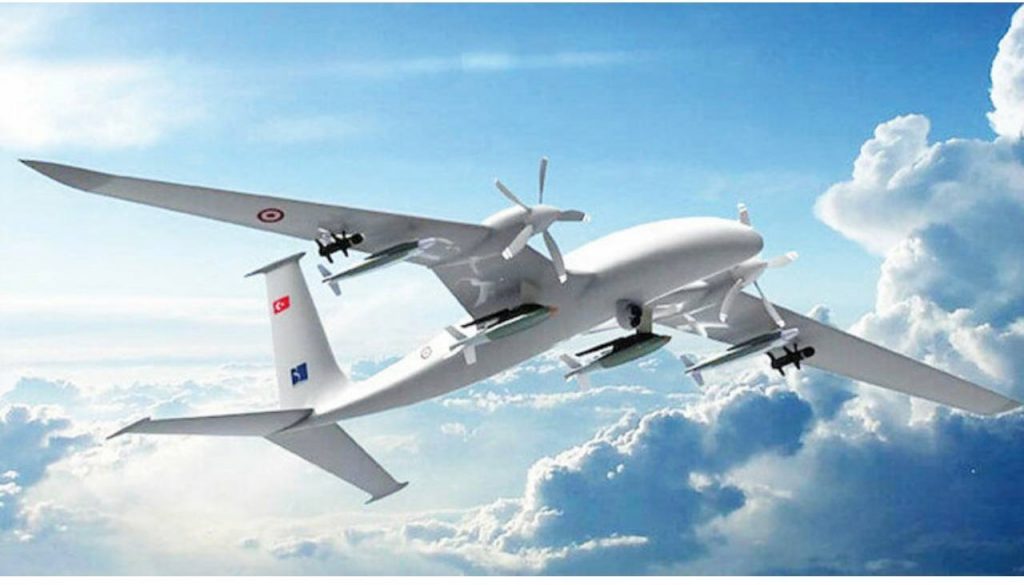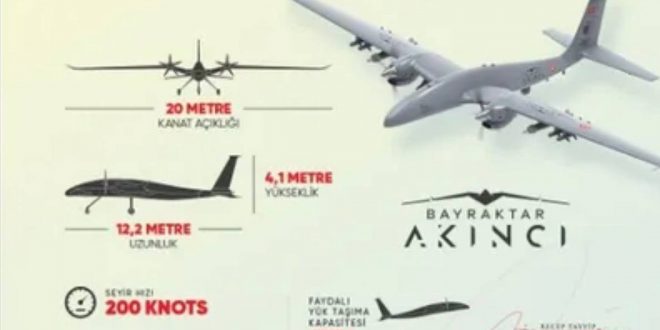Turkey aims to establish a completely independent foreign policy that will be supported by its own national defense powers, so that Turkey will not be dictated to by external international forces, but rather make free, independent strategic moves.

By the year 2018, Turkey had already made noticeable progress in the area of combat drones, such as UCAVs, which were utilized in military operations by the Turkish Armed Forces. To illustrate, the Bayraktar TB2, which was Turkey’s first locally armed UAV system, was utilized to perform its first mission in 2016. Toward the end of 2019, Turkey was reported to rank second among countries that used lethal drones in the world.
With a determined drive to become a great power, Turkish President Recep Tayyip Erdogan aims to become a part of the world’s dominant military powers and is, thus, in pursuit of developing an internationally renowned armory. It is to this end that a light aircraft carrier as a supra-regional operational platform was constructed. Turkey aims to establish a completely independent foreign policy that will be supported by its own national defense powers, so that Turkey will not be dictated to by external international forces, but rather make free, independent strategic moves.
There are several foundations behind the success of the Turkish system. The first of these is the burden and combat capacity imposed on defense economies, which we can call the price-quality balance. In the examples of Libya, Syria, Iraq, and counter-terrorism operations, most recently in Karabakh, in a conventional war situation, we see that Turkish drone systems come with very serious experience based on thousands of flight hours. The Wall Street Journal made a headline about the Bayraktar TB2. It was stated in the news article that the Turkish-made UAVs restructured the war fields. Drawing attention to the performance and cost-effectiveness of the Bayraktar TB2 when compared with its equivalences, it was stated that Syria, Libya, and Azerbaijan canalized the condition against Russia-supported powers. The TB2 Bayraktar drone is important for securing Turkish gas drilling and putting pressure on South Cyprus and Greece, which have a dispute with Ankara over the eastern Mediterranean gas fields. Israel’s direct interest in developments in the Mediterranean region and the dispute over water boundaries and the exploitation of seabed fossil resources is a source of serious controversy in the first circle of Ankara’s security system.
Qatar is the first buyer of Turkish drones
Turkey’s first customer in the field of UAVs and, at the same time, its closest ally in the Middle East was Qatar. In the year 2012, Qatar purchased a mini hand-launched UAV from the Baykar defense company, and in 2018, Qatar ordered six Bayraktar TB2s and became the first foreign customer of this vehicle. Qatar was followed by Ukraine in 2019. After six items of TB2 were delivered to the air forces in the year 2020, orders were also given for the sea forces. Moreover, Ukraine started to support Turkey’s projects with its developed motor industry. The turboprop engines produced by Ivchenko-Progress for the Akinci combat UAV project were provided by the Baykar Defense Company. Another Ukraine company, Motor Sich will provide the turboshaft engines on which the T929 heavy class attack helicopters operate.
Polish Defense Minister Mariusz Błaszczak made important statements about the Bayraktar TB2s that his country bought from Turkey. When asked why the Polish Ministry of Defense decided to procure Bayraktar TB2s, Minister Błaszczak said, “My aim is to modernize the Polish Army and continuously improve our country’s defense. Thanks to this agreement, Poland will have a very effective unmanned aerial vehicle that has been proven in conflict areas and wars.” Iraq will purchase drones, combat helicopters, and mobile electronic warfare systems manufactured by Turkey, Baghdad’s Defense Minister Juma Anaad Sadoun said. As reported by Yeni Şafak Daily, the minister announced an agreement to purchase a Bayraktar TB2 UAV, 12 T129 ATAK helicopters, and six KORAL mobile electronic warfare systems from Ankara. He attended the International Defense Industry Exhibition in Istanbul on August 17-21, 2021, and held meetings with senior officials of the Turkish defense.
Apart from ANKA-Aksungur, another development that excited everyone in the sector was the first test run of the Bayraktar Akinci Combat Unmanned Aerial Vehicle (TIHA). Akinci TIHA, which performed its first successful flight in December 2019, made Turkey one of the three countries having unmanned aerial vehicles that meet these standards. Possessing both line-of-sight and beyond-line-of-sight communication capabilities, and thus having satellite control capability, Bayraktar Akinci can be controlled from anywhere. Bayraktar Akinci, which has in-built artificial intelligence computers and high conditional awareness with its AESA Radar, will relieve the burden of the warplanes operating with the air-air ammunition called Gokdogan and Bozdagan, developed by TUBITAK SAGE. In addition, Bayraktar Akinci TIHAs will undertake the combat function with such ammunition as nationally produced general-purpose bombs, control kits and SOM monitory missiles. In parallel to the development of Akinci TIHA, Bayrak Company is also carrying out work for the MIUS (Combatant Unmanned Plane System) project.
Turkish drones in Syria and Azerbaijan proved to the world the fact that “the biggest enemy of tanks is drones now.” Moreover, it should not be forgotten that enemy drones and helicopters will be much more helpless against air-to-air missiles fired from Akinci or Aksungur. On the other hand, because there is no pilot in it, it would be very difficult to separate friendly-enemy elements in close air warfare, it should be able to motivate missiles with a bidirectional data link, it should even have network-centered warfare technologies such as link-16, and the drone, which is very slow compared to warplanes. It should not be forgotten that missiles fired from missiles will also be disadvantaged in terms of range, as their initial speed will be lower than missiles fired from enemy planes due to the laws of physics. In other words, there are more distances to be covered by drones in air-to-air warfare and more problems for manufacturers to solve.
Speaking at the delivery ceremony of the Baykar Akıncı Unmanned Combat Aerial Vehicle, Turkish President Erdogan said: “Our defense industry has played a leading role in the success story Turkey has written in the past 19 years. The level we have reached in UAV technologies symbolizes the success of our capabilities in the defense industry, which is acknowledged by the entire world.” Erdogan delivered a speech at the course completion and delivery ceremony of the Bayraktar Akinci Unmanned Combat Aerial Vehicle (UCAV). “We have gathered here today for the delivery of Akinci UCAV, which is the new symbol of Turkey’s engineering capabilities and the new representative of our independence in the sky,” the level we have reached in UAV technologies symbolizes the success of our capabilities in the defense industry, which is acknowledged by the entire world,”
The Akinci deserves the utmost attention in this respect. Designed and produced by Baykar, the makers of the signature Bayraktar TB2, the Akinci will have a payload of 1,350 kilograms. This drastic increase in combat payload capacity will enable the platform to carry game-changer munitions such as the SOM-A indigenous cruise missile with a range of 250 kilometers. The other game-changer for UAS will be Aksungur, especially with respect to the naval balance of power. TUSAS’ Aksungur will carry a magnetic anomaly detector (MAD) and a sonobuoy, which remain essential tools for anti-submarine warfare (ASW). In fact, present writings on the ASW functions attach critical importance to relying more on unmanned systems to alter the Cold War-remnant electronic intelligence, manned patrol aircraft, surface vessels, and submarine chain to detect hostile submarines. This intention makes even more sense in the age of COVID-19 austerity measures in defense economics. Unmanned systems are cheaper to field and operate, and more expendable as they do not risk friendly lives. 27 members of the US House of Representatives wrote to the Secretary of State claiming that Turkish drones are destabilizing parts of the world and threatening US interests, allies, and partners. US lawmakers said Turkish drones were stationed in Azerbaijan, Syria, and Libya. “Turkish officials say it has become the world’s fourth-largest drone maker since Ankara focused on domestic production in an effort to reduce its dependence on Western weapons.”
Turkey is one of the 10 countries in the world that designs and builds its own warships. The country has more than 700 defense projects, up from just 62 in 2002. Being strong militarily, economically, and diplomatically is a necessity and not a choice. Turkey has to reach the highest level of deterrence, and this is necessary to ensure national security and defend its friends. According to Ismail Demir, head of the Turkish Presidential Defense Industries Office, major Turkish defense projects are still ongoing. UAVs capable of launching air-to-air missiles are on their way, and the Turkish warplane will leave the hangar in 2023. In addition to current drones, larger drones capable of carrying heavier ammunition and capable of launching air-to-air missiles are on the way.
Turkey plans to increase its current arms exports, which now stand at around 2.8 billion euros, to more than 9.3 billion euros by 2023, the 100th anniversary of its founding, so it is working to produce more drones. The delivery of Akinci drones to the Turkish army shows the Turkish government’s continued attention to the defense industry, and especially to advanced technologies in this field. As a country planning to become an energy hub, Turkey could use drones for the physical security of energy infrastructure and pipelines. Due to the existing tensions in the world, Turkey has the potential to increase its volume of arms exports, and the UAV industry is one of Turkey’s winning cards in this field. The modern and advanced armies of the world are now trying to understand and coordinate with their forces the doctrine of the new war and the success of Turkish drones in the face of asymmetric and conventional threats. Turkey has also taken another step in the mass production of Akinci and Axungor drones, which are top models of the Anka and TUB 2. With drone technology, Turkey is proving to be a regional power, and in the face of the great powers, it is changing the fate of major wars such as Syria, Libya, and Karabakh. UAVs can be the winners of Turkey’s foreign policy in the region as well as in energy equations in the region, especially in the Black Sea and the Mediterranean.
- https://menaaffairs.com/





